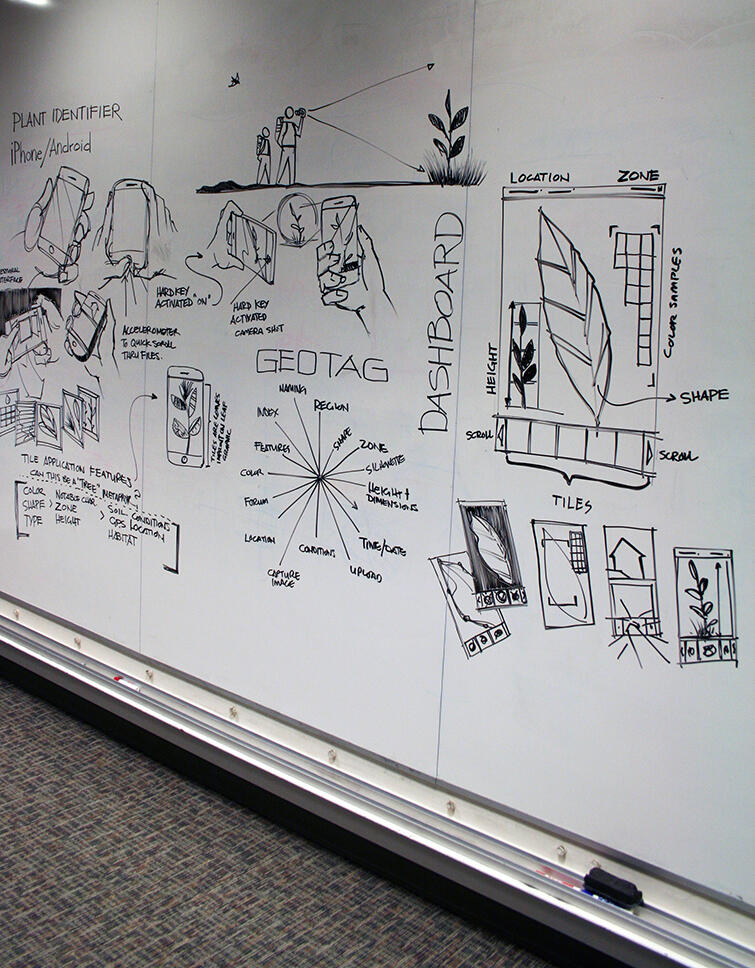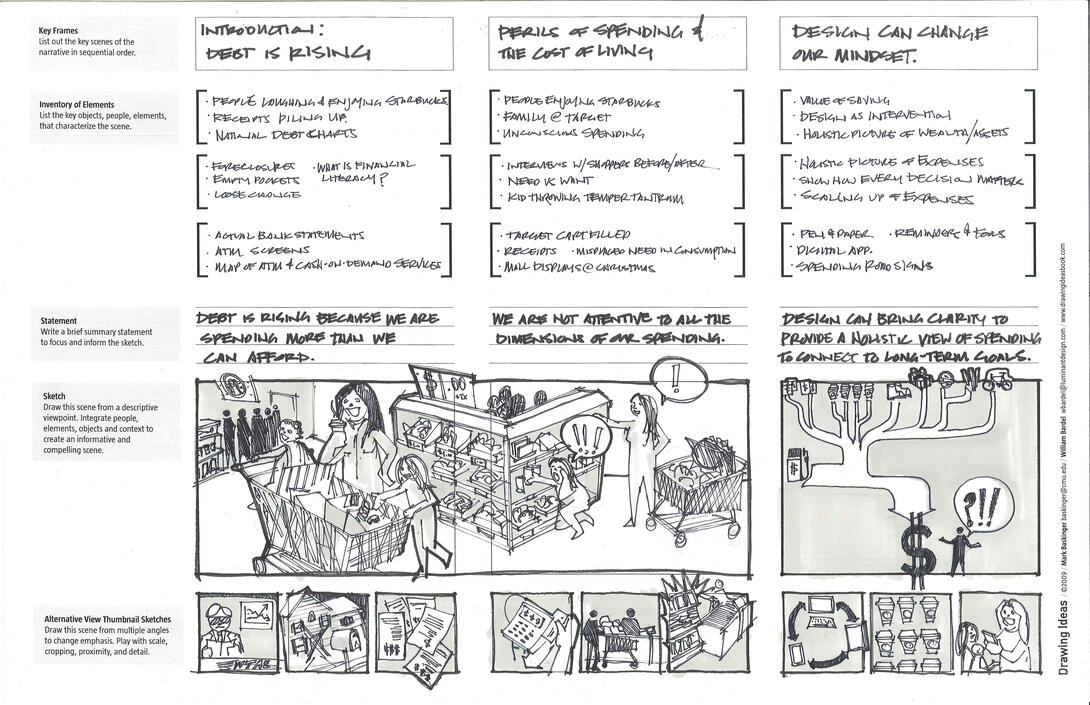The Joseph Ballay Center for Design Fusion provides several exciting course opportunities in concert with programs in the School of Design.
The Ballay Center offers a vibrant learning environment to ignite creativity and exploration open to the entire campus community. Our courses offer specialized and contemporary topics and integrate diverse interests from within and outside of design to inspire students to think beyond convention and push the boundaries of design. With a focus on interdisciplinary learning, the Ballay Center provides space for students to explore their passions and develop design skills that are relevant and exciting in today's rapidly evolving world. In SIO, students can search “Design Fusion” for available courses each semester.
Courses specifically developed to provide design skills and methods for academic units are tailored and co-developed in partnership with faculty and academic advisors to provide the most impactful pedagogical fit. Academic advisors and unit leaders interested in dedicated Ballay Center courses should contact BallayCenter@design.cmu.edu
Courses for 2024-2025
The Ballay Center offers a variety of full- and half-semester courses that explore contemporary design practice, research, and interest areas. Our courses aim to provide new and exciting opportunities for CMU students to work in collaborative and creative ways – pushing boundaries, sharing knowledge, and fusing disciplines. We frequently add new courses throughout the academic year listed in the course catalog with a 51-5## series number.
-
Natural patterns have fascinated humans for thousands of years. Explore the diversity of insect visual design, from super-sneaky camouflage to the loudest warning signals; learn why patterns occur in nature and how form and function intersect in insects. Use hands-on, up-close examination of museum specimens to study and illustrate your own original bio-inspired artwork. This course is offered through the Joseph Ballay Center for Design Fusion and is open to those with basic drawing proficiency and Photoshop skills.
-
How do insects build complex and efficient mechanical structures that rival human technology? What is the basic insect toolkit, and how have beetles adapted it to create glowing light, fire detectors, explosive weaponry, and color-changing armor? Explore these questions and examine the world’s most remarkable bugs up close, with specimens from the Carnegie Museum of Natural History. This course is offered through the Joseph Ballay Center for Design Fusion. This course is open to those with basic drawing proficiency and Photoshop skills.
-
Explore what distinguishes good ideas from great ideas and develop skills for ideating, developing, and visualizing a compelling concept that resonates with clients - in an agency-like environment. This course is offered through the Joseph Ballay Center for Design Fusion. Students must have visual drawing and image-making skills with access to Adobe Creative Cloud (Photoshop, Acrobat, Illustrator, etc), Powerpoint or similar presentation-making software.
-
The discipline of design is motivated by a drive to make things better. It can be very difficult, however, to maintain a genuine engagement required to address the biggest challenges we face, when our personal, social, civic, economic and environmental anxieties take so much of our energy. How can we sustainably apply our creative problem solving when we regularly feel overwhelmed? Designing for Presence helps us nurture ourselves and our connections as part of our practice of improving the world. Through a combination of readings, seminar discussion, mindfulness practices and a collaborative project, we will simultaneously fortify ourselves, cultivate empathy toward others, and explore practical design interventions to a real issue affecting the local community.
-
Our modern lives are flooded with data. This course provides an introduction to designing with data for non data-scientists and uses a project-based approach to explore types, formats, sources, and the visual presentation of different types of data. Students will work with a variety of qualitative, quantitative and experimental data sources. While there are no prerequisites for the course, students should have a working knowledge of some form of software that can be used to analyze and visualize data, including (but not limited to), Excel, Adobe Creative Cloud (Illustrator, Photoshop, etc), Google sheets, Apple Numbers, Sketch, Miro, Figma, etc.
-
Whether you are drafting a business plan, building a home, designing an app, or commissioning a piece of art, the intent and clarity of an idea is reliant on the fidelity and form of how it is communicated. Written forms of communication can be misinterpreted; existing reference imagery can be too limiting; but drawing offers an opportunity to specify exact detail and reflect the creator's imagination to the nth degree- all that is needed are the skills to capture those details. This course will explore the ways we can synthesize, distill, and communicate the essence of an idea through drawing. Prior drawing experience is not required.
Micro Courses
Micro courses are stand-alone short course experiences that focus on contemporary themes. Offered by School of Design faculty, these educational experiences are established for faculty to exercise their research practices with students and often include co-teaching with colleagues in other disciplines and industry professionals.
-
This micro course is an immersive, hands-on session designed to unlock your potential for on-the-fly visual thinking through developing better drawing skills, visual notation, diagramming and storyboarding. Aiming to improve your whiteboard sketching when leading a meeting, each participant will learn methods and techniques for expressing their ideas quicker and with more confidence - in front of others.
Image
-
Visual Thinking applies the School of Design's unique methods of sketching, diagramming, and storyboarding in support of collaborative and generative design processes. Through rich and effective sketching, our approach builds a visual record to translate practices of observing, forecasting, making, researching, and validating, into highly developed ideas.
Image
-
Human-centered design (HCD) has been an effective approach to problem-solving that involves understanding the needs, behaviors, and preferences of the people who will ultimately use a product, service, or system being designed. In today's design landscape, we consider broader issues of culture, society, and environment as central to a human-centered design process while fostering a deep understanding of the users' perspectives and experiences. Operating at these two levels of scale provides for a robust perspective that advocates for the individual and the collective.
Image
-
This micro course introduces approaches and strategies for designing information that creates meaning for various audiences and contexts. Students experiment with a range of design techniques from hand-drawn visual notation to computational data modeling.
Image
Image courtesy of William Bardel / Luminant Design
-
Deep time communication refers to the concept of transmitting messages or information to human recipients in the distant future, spanning thousands of years. As design inquiry, this raises profound philosophical and practical questions about how might communicate across vast spans of time, considering factors such as linguistic evolution, temporal/cultural contexts, and materiality; and prompts reflection on humanity's place in the universe and our desire to project forward for future generations.
ImageImage courtesy of CMU MoonArk
-
Great ideas presented poorly can hamper any design process. Learn how to visually articulate ideas and concepts in more compelling and effective ways that engage your audience, deliver the substance of your process, and promote deeper understanding.
Image
Designathons
Designathons are high-profile, short-term and industry-funded opportunities developed in collaboration with other academic units on campus to explore contemporary issues. Typically ranging from 1 to 3 sessions, these immersive and exciting intensives are aimed at breaking disciplinary paradigms to allow students and faculty to work in new and highly collaborative ways. Designathons are hosted in the Ballay Center and make use of the prototyping labs and specialized facilities in the School of Design.
For information and inquiries for sponsoring a Designathon, please contact: BallayCenter@design.cmu.edu
-
Image
